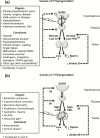A Perspective on Middle-Aged and Older Men With Functional Hypogonadism: Focus on Holistic Management
- PMID: 28359097
- PMCID: PMC5477803
- DOI: 10.1210/jc.2016-3580
A Perspective on Middle-Aged and Older Men With Functional Hypogonadism: Focus on Holistic Management
Abstract
Context: Middle-aged and older men (≥50 years), especially those who are obese and suffer from comorbidities, not uncommonly present with clinical features consistent with androgen deficiency and modestly reduced testosterone levels. Commonly, such men do not demonstrate anatomical hypothalamic-pituitary-testicular axis pathology but have functional hypogonadism that is potentially reversible.
Evidence acquisition: Literature review from 1970 to October 2016.
Evidence synthesis: Although definitive randomized controlled trials are lacking, evidence suggests that in such men, lifestyle measures to achieve weight loss and optimization of comorbidities, including discontinuation of offending medications, lead to clinical improvement and a modest increase in testosterone. Also, androgen deficiency-like symptoms and end-organ deficits respond to targeted treatments (such as phosphodiesterase-5 inhibitors for erectile dysfunction) without evidence that hypogonadal men are refractory. Unfortunately, lifestyle interventions remain difficult and may be insufficient even if successful. Testosterone therapy should be considered primarily for men who have significant clinical features of androgen deficiency and unequivocally low testosterone levels. Testosterone should be initiated either concomitantly with a trial of lifestyle measures, or after such a trial fails, after a tailored diagnostic work-up, exclusion of contraindications, and appropriate counseling.
Conclusions: There is modest evidence that functional hypogonadism responds to lifestyle measures and optimization of comorbidities. If achievable, these interventions may have demonstrable health benefits beyond the potential for increasing testosterone levels. Therefore, treatment of underlying causes of functional hypogonadism and of symptoms should be used either as an initial or adjunctive approach to testosterone therapy.
Figures


Similar articles
-
Testosterone Replacement Therapy Added to Intensive Lifestyle Intervention in Older Men With Obesity and Hypogonadism.J Clin Endocrinol Metab. 2021 Mar 8;106(3):e1096-e1110. doi: 10.1210/clinem/dgaa917. J Clin Endocrinol Metab. 2021. PMID: 33351921 Clinical Trial.
-
Testosterone deficiency in men with Type 2 diabetes: pathophysiology and treatment.Diabet Med. 2020 Feb;37(2):174-186. doi: 10.1111/dme.13977. Epub 2019 Jun 4. Diabet Med. 2020. PMID: 31006133 Review.
-
Androgen deficiency in older men.Aust J Gen Pract. 2019 Jul;48(7):446-450. doi: 10.31128/AJGP-01-19-4831. Aust J Gen Pract. 2019. PMID: 31256511
-
Androgen deficiency in the etiology and treatment of erectile dysfunction.Urol Clin North Am. 2005 Nov;32(4):457-68, vi-vii. doi: 10.1016/j.ucl.2005.08.002. Urol Clin North Am. 2005. PMID: 16291037 Review.
-
[Patient with testosterone deficit syndrome and erectile dysfunction non-responder to PDE-5 inhibitors].Arch Esp Urol. 2013 Sep;66(7):723-8. Arch Esp Urol. 2013. PMID: 24047632 Review. Spanish.
Cited by
-
Is There Room for SERMs or SARMs as Alternative Therapies for Adult Male Hypogonadism?Int J Endocrinol. 2020 Jan 21;2020:9649838. doi: 10.1155/2020/9649838. eCollection 2020. Int J Endocrinol. 2020. PMID: 32411230 Free PMC article. Review.
-
TESTOSTERONE AND INSULIN RESISTANCE IN MEN: EVIDENCE FOR A COMPLEX BI-DIRECTIONAL RELATIONSHIP.Trans Am Clin Climatol Assoc. 2025;135:297-305. Trans Am Clin Climatol Assoc. 2025. PMID: 40771640 Free PMC article.
-
Male Obesity-related Secondary Hypogonadism - Pathophysiology, Clinical Implications and Management.Eur Endocrinol. 2019 Aug;15(2):83-90. doi: 10.17925/EE.2019.15.2.83. Epub 2019 Aug 16. Eur Endocrinol. 2019. PMID: 31616498 Free PMC article. Review.
-
Acquired Male Hypogonadism in the Post-Genomic Era-A Narrative Review.Life (Basel). 2023 Sep 1;13(9):1854. doi: 10.3390/life13091854. Life (Basel). 2023. PMID: 37763258 Free PMC article. Review.
-
A Clinical Perspective of Sleep and Andrological Health: Assessment, Treatment Considerations, and Future Research.J Clin Endocrinol Metab. 2019 Oct 1;104(10):4398-4417. doi: 10.1210/jc.2019-00683. J Clin Endocrinol Metab. 2019. PMID: 31042277 Free PMC article. Review.
References
-
- Bhasin S, Cunningham GR, Hayes FJ, Matsumoto AM, Snyder PJ, Swerdloff RS, Montori VM; Task Force, Endocrine Society . Testosterone therapy in men with androgen deficiency syndromes: an Endocrine Society clinical practice guideline. J Clin Endocrinol Metab. 2010;95(6):2536–2559. - PubMed
-
- Wang C, Nieschlag E, Swerdloff R, Behre HM, Hellstrom WJ, Gooren LJ, Kaufman JM, Legros JJ, Lunenfeld B, Morales A, Morley JE, Schulman C, Thompson IM, Weidner W, Wu FC; International Society of Andrology (ISA); International Society for the Study of Aging Male (ISSAM); European Association of Urology (EAU); European Academy of Andrology (EAA); American Society of Andrology (ASA) . Investigation, treatment, and monitoring of late-onset hypogonadism in males: ISA, ISSAM, EAU, EAA, and ASA recommendations. J Androl. 2009;30(1):1–9. - PubMed
-
- Bojesen A, Juul S, Gravholt CH. Prenatal and postnatal prevalence of Klinefelter syndrome: a national registry study. J Clin Endocrinol Metab. 2003;88(2):622–626. - PubMed
-
- Harman SM, Tsitouras PD. Reproductive hormones in aging men. I. Measurement of sex steroids, basal luteinizing hormone, and Leydig cell response to human chorionic gonadotropin. J Clin Endocrinol Metab. 1980;51(1):35–40. - PubMed
-
- Neaves WB, Johnson L, Porter JC, Parker CR Jr, Petty CS. Leydig cell numbers, daily sperm production, and serum gonadotropin levels in aging men. J Clin Endocrinol Metab. 1984;59(4):756–763. - PubMed
Publication types
MeSH terms
Substances
LinkOut - more resources
Full Text Sources
Other Literature Sources
Medical

